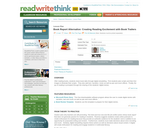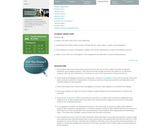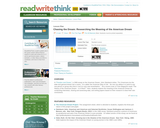
Students will consider literary works including Mary Shelly's Frankenstein and research their respective "back stories." They then design posters illustrating their information for display.
- Provider:
- New York Times
- Date Added:
- 06/24/2019

Students will consider literary works including Mary Shelly's Frankenstein and research their respective "back stories." They then design posters illustrating their information for display.

Noh, the oldest surviving Japanese dramatic form, combines elements of dance, drama, music, and poetry into a highly stylized, aesthetic retelling of a well-known story from Japanese literature, such as The Tale of Genji or The Tale of the Heike. This lesson provides an introduction to the elements of Noh plays and to the text of two plays, and provides opportunities for students to compare the conventions of the Noh play with other dramatic forms with which they may already be familiar, such as the ancient Greek dramas of Sophocles. By reading classic examples of Noh plays, such as Atsumori, students will learn to identify the structure, characters, style, and stories typical to this form of drama. Students will expand their grasp of these conventions by using them to write the introduction to a Noh play of their own.

Students learn alternatives to the classic classroom assignment, the book report.

This resource from the New York Times contains a collection of teaching ideas that commemorate poet Maya Angelou, including writing and reading activities.

In this lesson, students select American authors to research, create timelines and biopoems, and then collaborate on teams to design and perform a panel presentation in which they role-play as their authors. The final project requires each student to synthesize information about his or her author in an essay.

In this Random House for High School Teacher's Guide for Black Swan Green, David Mitchell's coming of age novel, students will explore vocabulary, author background, discussion questions, writing prompts, and extension ideas designed to enhance student understanding of character, theme, and structure.

This lesson is designed to help students prepare to read a historical novel. Students are required to complete research pertaining to the work's setting, time-period or decade. Afterwards, students use the online site and software, Prezi, to communicate and share their findings.

This Random House for High School Teachers teacher's guide includes questions, discussion topics, comparison to other texts, and an author biography designed to aid students in exploring Bombingham by Anthony Grooms. Through the compelling narration of Walter Burke, a troubled young soldier caught in the crossfire in Vietnam, Grooms examines the complex intersection of segregation, civil rights, and racism in one city’s past.

After reading books, students share book talks through digital storytelling. First, students plan scripts and then find images to illustrate their scripts. They also add text, narration, music as well as pan and zoom effects. Finally, the joy of reading is prompted through the sharing of the students' digital stories.

By mimicking popular websites that relate the plot of movies, television shows, and real life events in reverse, students have the opportunity to review the plot in a more creative and challenging fashion. Using a snowclone (a verbal formula that is changed for reuse), students complete the phrase "If you read ____ backwards, it's about ____" to comment on the plots of novels.

Teachers generally warn student writers to avoid sentence fragments but professional writers use sentence fragments effectively for a variety of reasons. Using Edgar Schuster's study of sentence fragments from "The Best American Essays," this lesson encourages students to examine fragments in action, determine their effective rhetorical uses, and reflect on their own uses of sentence fragments.

This brochure assignment teaches how shifting purposes and audiences can create change in a student’s writing. After exploring published brochures, students determine key questions, research a topic and work through the writing process to create their own informative brochure complete with visuals.

In this lesson, students will confirm, negate, and build information about the nation’s changing demographic using an organizational chart; write a letter to respond to a viewpoint offered in the central text; and talk about their own multiple identities in relation to those around them.

In this slide share presentation based on Chinua Achebe's book, Things Fall Apart, students will learn how to effectively set up a character analysis essay through viewing examples and tips. However, this lesson could be adapted for other novels as well.

In "Paradox and Dream," a 1966 essay on the American Dream, John Steinbeck writes, "For Americans too the wide and general dream has a name. It is called "the American Way of Life.' No one can define it or point to any one person or group who lives it, but it is very real nevertheless." Yet a recent cover of Time Magazine reads "The History of the American Dream " Is It Real?" Here, students explore the meaning of the American Dream by conducting interviews, sharing and assessing data, and writing papers based on their research to draw their own conclusions.

In this lesson, students will research and prepare an almanac on the Arctic. They then examine the laws that attempt to provide jurisdiction over this area and consider how these laws will be affected if geography of the Arctic continues to change due to the effects of global warming.

When it comes to formal writing, most students choose passive voice constructions because to them, the verbs sound more academic or more formal. This minilesson explores verb choice in a variety of online resources then encourages students to draw conclusions about verb use. Then they explore the pieces they are writing, checking for active and passive voice, and make necessary revisions.

This lesson focuses on A Christmas Memory, a short story by Truman Capote. Students read the text independently and answer text-dependent questions before beginning work on a written assignment that accompanies the text.

In this lesson, which can be paired with any number of texts based during the Civil War, students create a five-paragraph character sketch of a character from the story they've recently read. Students outline the sketch before starting to write, then assess each others' work with a rubric.

In this lesson, students will learn how to identify and use varied syntax and transitional words and phrases. Students will revise their arguments and then work with peers to help review one another's work.